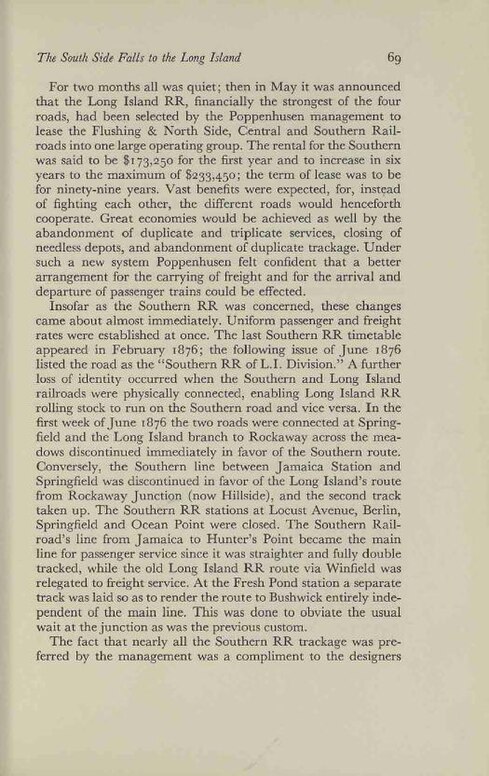For two months all was quiet; then in May it was announced that the Long Island RR, financially the strongest of the four roads, had been selected by the Poppenhusen management to lease the Flushing & North Side, Central and Southern Railroads into one large operating group. The rental for the Southern was said to be $173,250 for the first year and to increase in six years to the maximum of $233,450; the term of lease was to be for ninety-nine years. Vast benefits were expected, for, instead of fighting each other, the different roads would henceforth cooperate. Great economies would be achieved as well by the abandonment of duplicate and triplicate services, closing of needless depots, and abandonment of duplicate trackage. Under such a new system Poppenhusen felt confident that a better arrangement for the carrying of freight and for the arrival and departure of passenger trains could be effected.
Insofar as the Southern RR was concerned, these changes came about almost immediately. Uniform passenger and freight rates were established at once. The last Southern RR timetable appeared in February 1876; the following issue of June 1876 listed the road as the "Southern RR of L.I. Division." A further loss of identity occurred when the Southern and Long Island railroads were physically connected, enabling Long Island RR rolling stock to run on the Southern road and vice versa. In the first week of June 1876 the two roads were connected at Springfield and the Long Island branch to Rockaway across the meadows discontinued immediately in favor of the Southern route. Conversely, the Southern line between Jamaica Station and Springfield was discontinued in favor of the Long Island's route from Rockaway Junction (now Hillside), and the second track taken up. The Southern RR stations at Locust Avenue, Berlin, Springfield and Ocean Point were closed. The Southern Railroad's line from Jamaica to Hunter's Point became the main line for passenger service since it was straighter and fully double tracked, while the old Long Island RR route via Winfield was relegated to freight service. At the Fresh Pond station a separate track was laid so as to render the route to Bushwick entirely independent of the main line. This was done to obviate the usual wait at the junction as was the previous custom.
The fact that nearly all the Southern RR trackage was preferred by the management was a compliment to the designers
